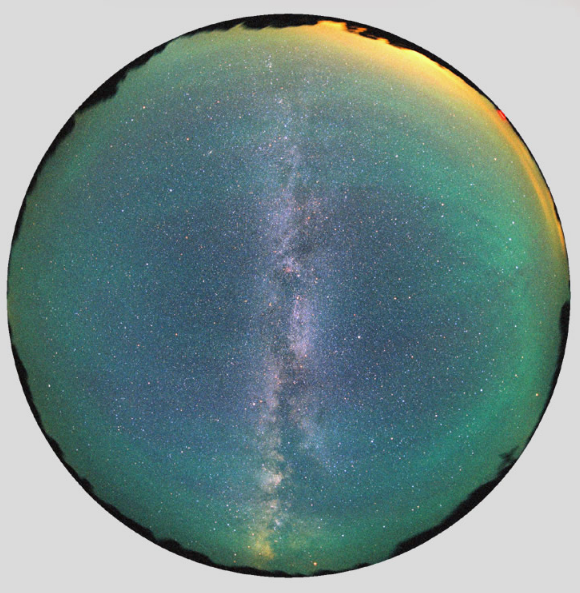Airglow all-sky image, Kansas
Airglow All-Sky Image: Unveiling the Enigmatic Nighttime Display
Have you ever gazed up at the night sky and marveled at its ethereal beauty? The heavens above us hold countless wonders, some of which are hidden from plain sight. One such enigmatic phenomenon is airglow. In this article, we will explore the captivating airglow all-sky image captured in Kansas, shedding light on the mesmerizing display that graces our atmosphere.
A Glimpse into the Kansas Airglow
The airglow all-sky image, taken by Doug Zubenel on August 13, 2001, in Lincoln County, Kansas, USA, offers a mesmerizing view of this celestial spectacle. Captured shortly after local midnight, the image showcases the airglow at its brightest, approximately 10-15° from the horizon. It reveals vibrant bands of light that are banded by gravity waves rising up through the mesosphere into the lower thermosphere.
Unraveling the Mysteries of Airglow
Airglow is a natural optical phenomenon that occurs when molecules and atoms in Earth's atmosphere emit light. This emission takes place due to various processes, such as recombination of ions and electrons or the relaxation of molecules after being excited by sunlight during the day. Unlike other atmospheric phenomena like auroras, airglow is a continuous emission that can be observed throughout the night.
The Intriguing Banding Effect
One of the striking features of the Kansas airglow image is the presence of distinct bands of light. These bands are created by gravity waves, which are oscillations in the density of the atmosphere. As these waves propagate upwards from the mesosphere to the lower thermosphere, they cause variations in airglow intensity, resulting in the banded appearance observed in the image.
A Glimpse of Kansas City's Glow
Intriguingly, the airglow all-sky image also captures a burst of yellow light at the 2 o'clock position. This light emanates from Kansas City, located approximately 60 miles away from the observation site. The distant city's artificial illumination adds a touch of urban radiance to the natural splendor of the airglow display.
Exploring the Science Behind Airglow
To fully appreciate the beauty of airglow, it is essential to understand the scientific mechanisms behind this captivating phenomenon. As sunlight interacts with Earth's atmosphere during the day, it excites atoms and molecules, causing them to enter an excited state. When these particles return to their ground state, they emit photons of light. This emission is responsible for the faint glow that permeates our atmosphere.
Unveiling the Colors of Airglow
Airglow manifests in various colors, including green, red, blue, and yellow. These colors are determined by the specific atoms and molecules present in the atmosphere and their corresponding energy levels. For example, green airglow is primarily caused by the emission of excited oxygen atoms at a specific wavelength. The Kansas airglow image predominantly showcases shades of green, enhancing its allure.
The Role of Airglow in Atmospheric Research
Beyond its visual appeal, airglow plays a crucial role in atmospheric research. Scientists can analyze the intensity and characteristics of airglow emissions to gain insights into the composition and dynamics of Earth's upper atmosphere. By studying airglow patterns, researchers can unravel details about atmospheric temperature, density variations, and the behavior of gravity waves.
Capturing the Essence of Airglow
Photographers like Doug Zubenel dedicate their time and expertise to capturing the breathtaking beauty of atmospheric phenomena like airglow. Through their lens, they freeze moments that allow us to witness the celestial wonders that unfold above us. The airglow all-sky image from Kansas serves as a testament to the power of photography in preserving and sharing the captivating mysteries of our planet.
Embracing the Night Sky's Enchanting Secrets
The airglow all-sky image from Kansas serves as a gateway into the mesmerizing world of atmospheric optics. It reminds us of the hidden beauty that envelops our planet, even in the darkness of the night. By delving deeper into the science behind airglow and appreciating its aesthetic allure, we can cultivate a greater appreciation for the wonders that abound in our vast universe. So, let us raise our eyes to the sky and embrace the enchanting secrets that await us in the celestial realm.

Kansas Airglow
Another all-sky image by Doug Zubenel taken August 13, 2001 shortly after local midnight, Lincoln County, Kansas, USA.
Airglow is usually brightest 10-15° from the horizon as here. It is banded by gravity waves rising up through the mesosphere into the lower thermosphere.
The yellow at 2 o'clock is the light from Kansas City about 60 miles away.
Image ©Doug Zubenel, shown with permission.
Note: this article has been automatically converted from the old site and may not appear as intended. You can find the original article here.
Reference Atmospheric Optics
If you use any of the definitions, information, or data presented on Atmospheric Optics, please copy the link or reference below to properly credit us as the reference source. Thank you!
-
<a href="https://atoptics.co.uk/blog/airglow-all-sky-image-kansas/">Airglow all-sky image, Kansas</a>
-
"Airglow all-sky image, Kansas". Atmospheric Optics. Accessed on April 23, 2024. https://atoptics.co.uk/blog/airglow-all-sky-image-kansas/.
-
"Airglow all-sky image, Kansas". Atmospheric Optics, https://atoptics.co.uk/blog/airglow-all-sky-image-kansas/. Accessed 23 April, 2024
-
Airglow all-sky image, Kansas. Atmospheric Optics. Retrieved from https://atoptics.co.uk/blog/airglow-all-sky-image-kansas/.